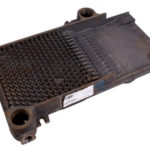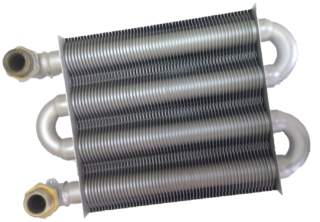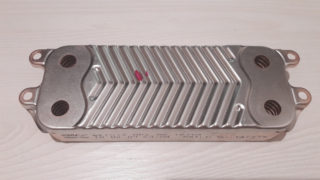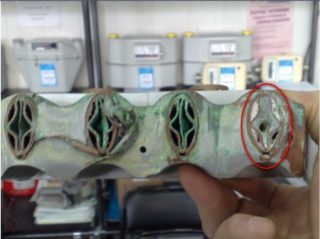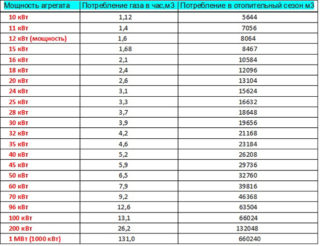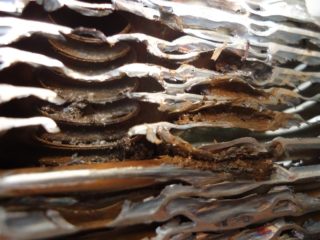Direct transfer of heat from burning fuel to the coolant is impossible. In heating boilers, it is performed due to the operation of a special device. This is a heat exchanger for a gas boiler. The life of the device and its efficiency depend on its design and material.
The main function of the heat exchanger for the boiler
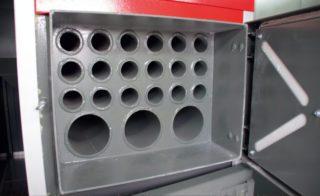
Gas and combustion air are supplied to the burner of the boiler. Gas burns, generating heat, combustion products are removed to the outside. The heat source in this case is a fixed element.
The coolant - water or antifreeze - enters the heat exchanger. This is a device that provides heat transfer between two environments with different temperatures. The latter is placed in the combustion chamber above the burner. Water moving through the heat exchanger is heated and fed into the heating pipes. Most often, the device has the form of a set of plates or tubes. The larger its working surface, the better and faster the water heats up.
Production material
A heat exchanger for the boiler is made of durable materials that conduct heat well, are not prone to corrosion and sufficiently resistant to pressure. Since you have to consider the cost of the material, the choice is small.
Steel
This is the most affordable material. Steel is very durable, but can be machined well. The price is low. Plus this option - resistance to high temperature. Steel is ductile and does not become cracked upon heating; it does not deform even in areas in contact with the burner.
A steel heat exchanger on a solid fuel or gas boiler is prone to corrosion. Water inside the tubes and combustion products in the boiler chamber have a destructive effect on the material. This affects longevity. The steel model weighs a lot, this leads to additional fuel consumption for heating the element itself.
The stainless steel heat exchanger is corrosion resistant and lasts at least 50 years.
Cast iron
The material is much more resistant to corrosion than steel, is not afraid of rust and acid anhydrides. The service life reaches 50 years. However, cast iron is a brittle alloy; it can crack under the influence of temperature. To avoid damage, the cast-iron tubular heat exchanger must be flushed: if ordinary water is used, then 1 time per year; if antifreeze - then 1 time in 2 years; if distilled liquid - 1 time in 4 years.
The weight of an element made of cast iron is even greater, so you have to spend more fuel and time on heating.
Copper
Copper is a noble metal, not subject to any kind of corrosion. It is chemically inert, perfectly tolerates pressure. Copper conducts heat better, so less fuel is needed to heat the element itself and the flowing liquid. The weight of the copper model is small, the dimensions are compact with a very developed work surface.
The disadvantage is the high price. Also, the copper heat exchanger is too sensitive to heat to high temperatures. More common in boilers from foreign manufacturers.
- Copper
- Cast iron
Heat Exchanger Classification
Gas boilers can perform several functions. The main thing is home heating. However, dual-circuit models also heat water for various household needs: from washing dishes to the bathroom. On this basis, heat exchangers are distinguished.
Primary
Serves the heating system.It is a pipe with a rather large diameter, curved in the form of a coil in one plane. To increase the working surface of the device, plates of different sizes are also placed here.
The primary heat exchanger is subjected to the highest loads. From the outside, combustion products act on it - soot, dirt, acid anhydrides, and from the inside - salts dissolved in the coolant. To reduce wear, the part is coated with paint and treated with anti-corrosion compounds.
The best option is a stainless steel or copper heat exchanger, as it is not susceptible to rust and is not afraid of salt deposits.
Secondary
Such a heat exchanger heats the liquid for hot water supply. The temperature of its heating is less, but it is not worth heating the water for domestic needs above +60 С. Most often this is a plate design: it is assembled from many plates with extruded passages along which tap water circulates. Multi-pass models are more effective, since within the same plate the liquid changes direction several times, that is, it is in it longer and warms up better. They make it from steel, copper, aluminum.
Bithermal
Represents 2 pipes inserted into each other. The coolant moves along the inside, and the water for the domestic hot water is on the outside. The heating fluid is heated in the combustion chamber and partially gives off heat to household water.
The design is much cheaper. But although the water here heats up faster, its volume is limited. In addition, the bithermic heat exchanger is very sensitive to water quality and is much more polluted. Cleaning the appliance is not enough. To prevent quick clogging and failure, it is necessary to install water filters at the inlet.
It is not possible to clean the combined heat exchanger as a regular separate one. With large deposits of salt or clogging, the element will have to be changed.
Criterias of choice
When choosing a device, the purpose is taken into account - in this case, it is heating the coolant, and the type of medium is steam, water, antifreeze. A gas boiler usually works with water, but there are exceptions.
Other selection criteria:
- The temperature of the coolant at the inlet and outlet - it is necessary to calculate how much heat should be received by the consumer. Based on these data, the heat exchanger power is calculated.
- Permissible pressure loss - the water pressure during passage through the heat exchanger decreases. If it falls too low, it is not possible to create a column of hot water of sufficient height.
- The maximum working temperature on the burner reaches 600–700 C. A cast-iron and steel heat exchanger, copper with some difficulty, can withstand this temperature. The aluminum model is not allowed.
- Maximum working pressure - does not limit the choice of structure or material.
A significant parameter is the dimensions. With the same efficiency, the shell-and-tube heat exchanger occupies an area 3-4 times larger than the plate-type heat exchanger.
Proper operation
Transportation, installation and operation of the heat exchanger are described in detail in the instructions:
- The heat exchanger in the apparatus is placed so that it has free access for inspection and repair.
- Startup is performed at stable pressure and temperature. You cannot increase the temperature faster than 10 degrees per minute or increase the pressure by more than 10 bar per hour.
- When filled with water, the air valves and the valves behind the heat exchanger remain open. After starting the pump, they are closed. In this way, a stable pressure is achieved.
- You need to change the heating parameters smoothly. The slower this happens, the longer the seals and the heat exchanger will last.
- Periodically clean the device.The plate is cleaned directly in the frame, then the plates are removed and washed. Another method is possible: first removing and then cleaning the plates. Shell and tube cleaning is not recommended. In case of difficult blockages, the master puts a stub.
- Before restarting, check the condition of all gaskets. Pressure and temperature are set as for 1 start.
To avoid salt deposits, a filter is placed on the water pipe in front of the boiler inlet.
Possible malfunctions
Most problems require specialist intervention. Some may be eliminated by the user:
- Pressure reduction - if caused by contamination, just clean the heat exchanger. If the network connection is incorrect, you need to verify the connection with the drawing in the instructions.
- Decrease in efficiency - at mechanical pollution the device is washed out. If the reason is the accumulation of oil, substandard gases, additional devices are installed to remove them.
- Leakage - most often caused by decomposition of the seals. They are being replaced.
- Mixing of working media - occurs when plates or tubes are corroded. The plates can be partially replaced; the shell-and-tube heat exchanger will have to be installed new.
As long as the warranty is valid, it is forbidden to open the heat exchanger yourself and carry out any repairs.
Popular manufacturers
Heat exchangers are produced by many manufacturers. The following companies were the most popular in 2019.
Navien
The largest Korean manufacturer. It produces products designed for domestic boilers. The advantage is resistance to low water quality and water hammer. The device is perfectly adapted to poor operating conditions.
Baxi
Italian manufacturer. Presents on the market wall-mounted and condensing boilers floor-mounted with a cast-iron heat exchanger, as well as electric heaters.
The company makes primary heat exchangers from copper and brass. For secondary lamellas stainless steel is used. This increases the cost of products, but provides maximum durability.
Other
There are other worthy manufacturers on the market:
- Fondital Victoria Compact is an Italian company. Offers high performance bithermic copper heat exchangers.
- Beleto is a well-known Russian plant that produces a variety of gas equipment. Makes steel, cast-iron and copper heat exchangers of various types.
- Ariston - offers aluminum and copper heat exchangers. Materials are insensitive to corrosion, and manufacturing technology guarantees their strength.
If there is a need to increase the efficiency of the boiler when replacing the device, consult with a specialist to calculate the required parameters.


